
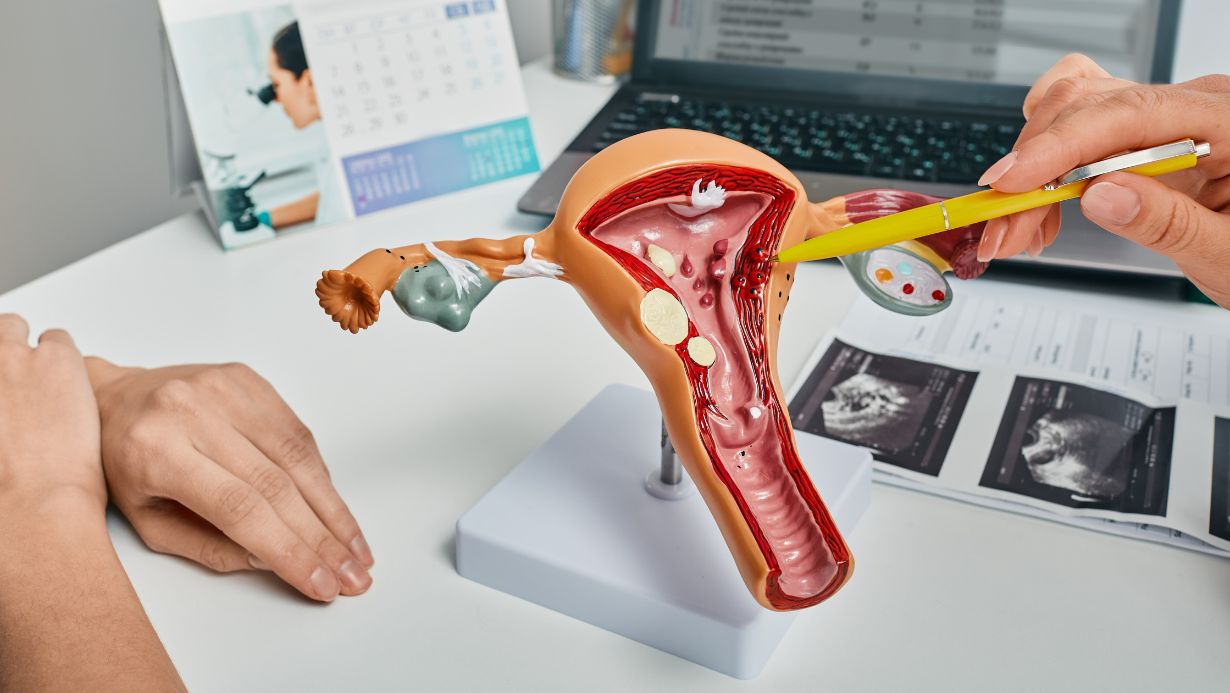
Namaste, dear friends! I’m Dr. Jagrati Laad, a compassionate MD in Obstetrics & Gynaecology, and I stand before you as a dedicated guide on your journey to parenthood.
In the tapestry of Indian culture, the dream of a family is intricately woven, and the anticipation of little footsteps can be both heartwarming and overwhelming. I understand the unspoken pressures from family, relatives, and society, who eagerly await the pitter-patter of tiny feet after marriage.
But sometimes, life takes unexpected turns. Despite your sincere efforts, the road to parenthood might be riddled with obstacles you didn’t foresee. This is where I want to hold your hand and shed light on a silent struggle that many face: endometriosis and uterine fibroids.
Imagine the desire to create a family, strong and unwavering, while hidden within lies a pain you can’t explain to the world. A pain caused by fibroids within your womb or by endometriosis, where your body’s own tissues play a cruel trick. You yearn for a baby’s laughter, but each month feels like a silent battle. The pressure mounts, questions arise, and you find yourself torn between dreams and uncertainties.
But, you’re not alone, and there is a path forward. Together, let’s navigate the intricate connection between these conditions and your dreams of parenthood. Let’s bring those dreams to life with knowledge, understanding, and tailored solutions. Your journey is one of resilience, hope, and the promise of new beginnings.
Did you know that endometriosis and uterine fibroids are two conditions that can cast a shadow on the path to parenthood? I am sure, most of you are unaware of it. Let’s discuss it in detail today.
Explore the link between endometriosis and fertility
Overcome endometriosis and fibroids with expert care
Navigating Fertility and Medical Conditions
The Role of Endometriosis and Uterine Fibroids
Endometriosis and uterine fibroids are two conditions that can cast a shadow on the path to parenthood. Endometriosis involves the growth of tissue outside the uterus, while uterine fibroids are noncancerous growths within the uterus. These conditions are more than just medical terms – they are challenges that many individuals face on their fertility journey.
Understanding Endometriosis
As said earlier, endometriosis, a complex condition, occurs when tissue similar to the lining of the uterus grows outside the uterus. This tissue can develop on the ovaries, fallopian tubes, and other areas, leading to pain, and inflammation, and potentially affecting fertility. Recognizing the symptoms, which may include pelvic pain, heavy periods, and discomfort during intercourse, is crucial for early diagnosis and intervention.
Tissue Growth Outside the Uterus
The growth of endometrial tissue outside the uterus can create adhesions, scar tissue, and cysts. These developments can impact reproductive organs, hindering their function and causing pain. Understanding the mechanisms behind this tissue growth is vital for tailoring effective treatment strategies.
Symptoms and Signs
Recognizing the signs of endometriosis empowers individuals to seek timely medical assistance. Symptoms such as chronic pelvic pain, fatigue, and digestive disturbances can’t be ignored.
Impact on Fertility
Endometriosis can pose a significant challenge to fertility. Adhesions and scar tissue can obstruct the fallopian tubes, impeding the journey of an egg to meet sperm. Additionally, inflammation caused by endometriosis can affect the environment within the uterus, potentially impacting implantation.
Adhesions and Scar Tissue: Obstructing the Path One of the ways endometriosis can hinder fertility is through the formation of adhesions and scar tissue. These adhesions are like “sticky” connections that can develop between the reproductive organs, such as the ovaries, fallopian tubes, and uterus. Think of them as tiny, invisible barriers that can block the natural flow of conception.
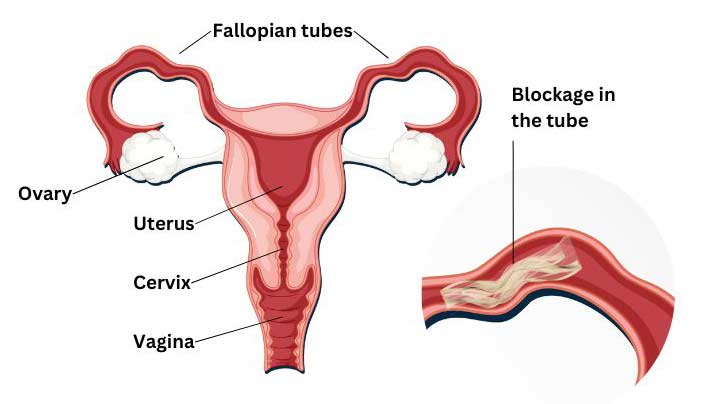
Blocked fallopian tubes
For instance, if adhesions form around the fallopian tubes, they might hinder the smooth movement of the egg from the ovary to the uterus. This obstructed path can make it significantly more challenging for the egg to meet the sperm, an essential step in the conception process. Imagine trying to navigate through a maze with unexpected obstacles – this is somewhat similar to what the reproductive cells face in the presence of adhesions.
Inflammation’s Impact on Implantation Beyond physical barriers, endometriosis can also create an unfavourable environment within the uterus due to inflammation. Inflammation occurs as a result of tissue growth outside the uterus, and this inflammation can extend to the uterine lining itself. The uterine lining, also known as the endometrium, plays a crucial role in providing a nurturing environment for the embryo during implantation.
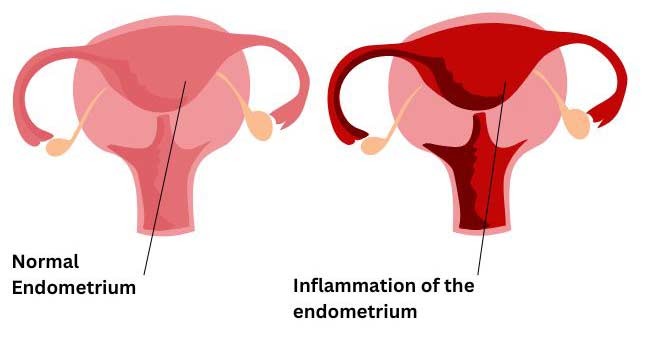
Inflammation of the endometrium
When inflammation is present, it can disrupt the delicate balance required for successful implantation. Think of the uterine lining as a receptive “bed” for the embryo to settle into and grow. If this bed is inflamed and disturbed, the embryo might face challenges in attaching securely, leading to a lower chance of pregnancy.
A Multifaceted Challenge Endometriosis doesn’t just pose a single challenge; it presents a multifaceted hurdle to fertility. From adhesions obstructing fallopian tubes to inflammation affecting the uterine environment, each aspect contributes to the complexity of the situation. It’s important to understand that these challenges are not insurmountable. With the right approach, tailored treatment, and expert guidance, individuals with endometriosis can still realize their dreams of parenthood.
Understanding Uterine Fibroids
Uterine fibroids, also known as leiomyomas, are benign growths that can develop within or on the uterus. While not inherently harmful, these growths can lead to discomfort, heavy bleeding, and other complications. Understanding the types of fibroids and their effects on fertility is crucial for informed decision-making.
Types of Fibroids
Fibroids come in various types, including subserosal (on the outer wall of the uterus), intramural (within the uterine wall), and submucosal (beneath the inner lining of the uterus). Each type can impact fertility differently, underscoring the need for accurate diagnosis and tailored treatment.
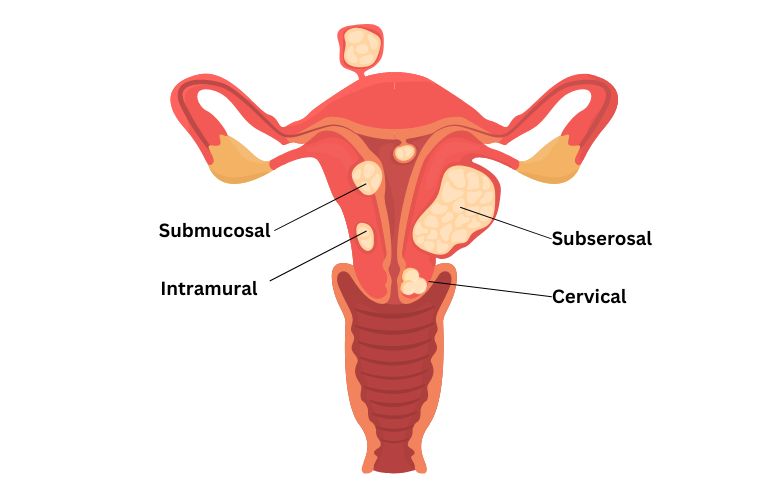
Types of fibroids
Effects on Fertility
The presence of fibroids can affect fertility in multiple ways. Depending on their size and location, fibroids might interfere with embryo implantation or create a less conducive uterine environment for pregnancy. Evaluating the individual’s unique situation is crucial for devising the most suitable fertility treatment plan.
Size and Location: Key Determinants
Uterine fibroids, benign growths that can develop within or on the uterus, can significantly impact fertility depending on their size and location. Imagine these fibroids as uninvited guests in your reproductive space – their presence can alter the dynamics of conception.
Interference with Implantation
In scenarios where fibroids are positioned within the uterine cavity or close to it, they might hinder the implantation of an embryo. Think of this as setting the stage for a play – a fibroid occupying a prime spot might leave little room for the embryo to settle in comfortably. This interference with implantation can lead to challenges in establishing a successful pregnancy.
Unique Challenges
Every individual’s journey is unique, and the impact of fibroids on fertility can vary widely. Let’s explore a few scenarios:
Multiple Fibroids: Individuals with multiple fibroids might face more intricate challenges. The size, location, and number of fibroids can collectively impact the ability to conceive. Expert evaluation is essential to devise a tailored plan that addresses each fibroid’s influence.
Conception Delays: Some individuals might experience delays in conception due to fibroids. These growths can affect ovulation or the journey of sperm to meet the egg. Timely intervention is crucial to address these delays and optimize the chances of pregnancy.
Fibroids During Pregnancy: In some cases, individuals might successfully conceive despite fibroids. However, the presence of fibroids during pregnancy can lead to concerns such as pain, premature labour, or complications. Monitoring and specialized care become paramount in such situations.
Devising a Suitable Treatment Plan
Evaluating the individual’s unique situation is pivotal in crafting an effective fertility treatment plan. Tailoring the approach to fibroids’ size, location, and impact of fibroids ensures that the most suitable interventions are chosen. These could range from medical management to surgical procedures, all aimed at optimising the conditions for conception. As a fertility expert, I guide you through these scenarios, providing clarity and personalized strategies.
The Interplay between Endometriosis, Uterine Fibroids, and Fertility
In some cases, individuals may face the dual challenge of dealing with both endometriosis and uterine fibroids. The combined impact of these conditions can create a complex scenario that demands expert management and care.
Navigating the challenges of endometriosis and uterine fibroids requires a tailored approach. Considering factors such as the severity of symptoms, the size and location of fibroids, and the individual’s overall health is essential when formulating a treatment plan.
Treatment Strategies and Options
Medical, Surgical, and Minimally Invasive Approaches
Addressing endometriosis and uterine fibroids involve a range of treatment options. From medical management to surgical interventions, such as myomectomy or laparoscopic surgery, each approach has its benefits and considerations. Generally, the treatment involves the following steps.
Effective minimally invasive options for endometriosis and fibroids
Minimally Invasive Approaches: The Future of Fibroid Treatment
Comprehensive Evaluation:
Understanding your unique situation is crucial. A comprehensive evaluation, involving imaging techniques like ultrasounds and possibly even MRI, will provide a clear picture of the size, location, and characteristics of both endometriosis lesions and fibroids. This assessment serves as the foundation for crafting a tailored treatment plan.
Medical Management
Depending on the severity and symptoms of your conditions, medical management might be considered. Medications can help manage pain associated with endometriosis and potentially slow down the growth of fibroids. Hormonal therapies can also regulate your menstrual cycle and reduce the impact of these conditions on your fertility.
Minimally Invasive Procedures
In cases where fibroids are causing significant fertility challenges, minimally invasive procedures like hysteroscopic myomectomy can be considered. This procedure involves the removal of fibroids using specialized instruments inserted through the vagina and cervix. This approach minimizes scarring and ensures a faster recovery.
Laparoscopic Surgery
It is an option when dealing with endometriosis. This minimally invasive approach involves making small incisions to access and remove endometriosis lesions. By removing or reducing the adhesions caused by endometriosis, the chances of successful conception can be improved.
Considerations for Both Conditions
When dealing with the combined challenge of endometriosis and fibroids, it’s essential to tailor treatments that address both conditions while considering their potential interactions. This is where expert fertility guidance comes into play. Your treatment plan might involve a combination of approaches to optimize your chances of successful conception.
Holistic Approach
The impact of these conditions extends beyond the physical aspect. The emotional toll can be significant, and a holistic approach to care is paramount. As a fertility expert, I am here not just to provide medical interventions but also to offer emotional support, coping strategies, and a safe space for the importance of Multidisciplinary Care
Collaboration among medical specialists, including gynaecologists, fertility experts, and pain management professionals, is essential. A multidisciplinary approach ensures that every aspect of the individual’s health and well-being is considered when designing a treatment plan.
Empowering Fertility: Overcoming Challenges, Embracing Success
Dealing with endometriosis and uterine fibroids can take an emotional toll. As a fertility expert, I am committed to providing a supportive space where patients can openly discuss their feelings, fears, and aspirations.
I offer guidance and coping strategies to help individuals navigate the emotional ups and downs that can accompany fertility challenges. From stress-reduction techniques to connecting with support groups, I empower my patients to take control of their emotional well-being.
Embarking on the path to fertility while overcoming the hurdles of endometriosis and uterine fibroids is a journey that requires expertise, compassion, and personalized care. I am here to be your partner and advocate throughout this transformative experience. Let’s conquer these challenges together and embrace the joy of parenthood.
Book Consultation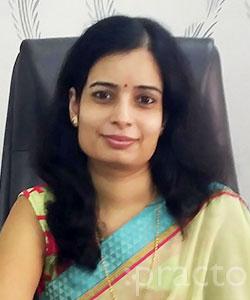
About the author
Dr. Jagrati Laad MD is an accomplished Obstetrician and Gynecologist specialist in Infertility Treatment. She has a Master's Degree in Medicine from SSG Hospital and Government Medical College Vadodara and is certified in Ultrasonography by FOGSI (The Federation of Obstetric and Gynecological Societies of India). Her Fellowship in Infertility from the reputed Nadkarni Hospital and Test Tube Baby Centre, Vapi, Gujarat has given her hands-on experience in assisting couples with infertility issues. Dr. Laad is passionate about Infertility treatment, management of High-Risk Pregnancies, Hysteroscopy, Antenatal Care, Laparoscopic Surgery, Adolescence Gynecology, Family Planning, and Cancer Detection and Treatment. Her expertise and dedication to her specialty have enabled her to expand the horizons of her field.








